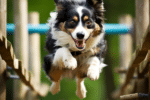Addressing Common Behavioral Issues in Dogs

As dog owners, it’s not uncommon to encounter behavioral issues with our furry companions. From aggression and anxiety to excessive barking, these behaviors can be challenging to manage. Addressing them is crucial for ensuring a harmonious and fulfilling relationship between you and your four-legged friend.
Behavioral issues such as aggression, anxiety, and barking can stem from a variety of factors including fear, lack of socialization, and environmental stressors. While some problems can be resolved through basic training and socialization, others may require the help of professionals who specialize in dog behavior.
In this series of articles, we’ll explore different common behavioral issues and provide insights into how you can effectively address them. From understanding the root causes and triggers to implementing positive training techniques, we’ll guide you on your journey to a well-behaved and happy canine companion.
Through expert advice and practical tips, we will cover topics such as dealing with aggression, managing fear and anxiety, controlling excessive barking, and addressing destructive chewing habits. Additionally, we’ll also tackle other problem behaviors like leash pulling, jumping up, resource guarding, begging, whining, and not responding to commands.
By understanding and addressing these issues head-on, you can create a peaceful and joyful environment for both you and your beloved pet. Let’s dive in and uncover the secrets to resolving common behavioral problems in dogs!
Dealing with Aggression
Aggression is a significant behavioral issue that many dog owners face. It not only poses a danger to humans and other animals but can also impact the overall well-being of the dog. Addressing aggressive behavior promptly is crucial to prevent any potential harm and create a harmonious environment for everyone involved.
When dealing with aggression in dogs, seeking help from local trainers or behavior counselors who specialize in reactive behaviors can be highly beneficial. These professionals are well-versed in using positive training techniques that focus on confidence-building and trust-building exercises to reduce reactivity.
Why Positive Training Techniques?
Positive training techniques, also known as force-free or reward-based training methods, are highly effective in addressing aggression. These methods use rewards such as treats, praise, and playtime to reinforce desirable behaviors and discourage unwanted ones. This approach not only helps in shaping appropriate responses but also strengthens the bond between the dog and its owner.
Using positive training techniques, such as reward-based methods, can help create a positive association with training, making it a more enjoyable experience for your dog.
Confidence-Building Exercises
Building your dog’s confidence is an essential aspect of addressing aggression. Confidence-building exercises focus on creating a sense of security, trust, and safety for the dog. These exercises can include controlled socialization with other well-behaved dogs, exposure to various environments, and obedience training to build a strong foundation of obedience and trust.
Additionally, activities that engage the dog mentally and physically, such as puzzle toys or exercise routines, can help redirect their energy in a positive way and reduce aggressive tendencies.
Key Points to Remember:
- Addressing aggression promptly is crucial to prevent potential harm.
- Seek help from trainers or behavior counselors who specialize in reactive behaviors.
- Positive training techniques focus on rewards and reinforcement.
- Confidence-building exercises help create a more secure and trusting dog.
By addressing aggression using positive training techniques and confidence-building exercises, dog owners can help their pets overcome their reactive behaviors and foster a more peaceful and harmonious bond between themselves and their dogs.
Managing Fear and Anxiety
Some dogs display fear and anxiety through their behavior, which can lead to various issues. They may exhibit fear around people, other dogs, or even going on walks. Addressing fear and anxiety in dogs is crucial for their well-being and the harmony of the household.
When it comes to managing fear and anxiety in dogs, seeking professional help is highly recommended. Behavior modification counseling provided by specialists who specialize in training anxious dogs can make a significant difference in addressing these issues.
Behavior modification counseling involves a comprehensive assessment of the dog’s behavior, identifying the underlying causes of fear and anxiety. This allows the counselor to develop a tailored training plan to help the dog overcome their fears and feel more comfortable in different situations.
Training and Behavior Modification Techniques
The training process for anxious dogs typically involves behavior modification techniques combined with positive reinforcement. These techniques aim to gradually desensitize the dog to their triggers and build their confidence.
One common behavior modification technique is counter-conditioning, where the dog is exposed to the fear-inducing stimulus in a controlled and positive manner. For example, if a dog is fearful of strangers, the counselor may introduce the dog to new people in a calm and controlled environment, rewarding the dog for calm and relaxed behavior.
“Behavior modification counseling involves a comprehensive assessment of the dog’s behavior, identifying the underlying causes of fear and anxiety.”
Another technique is called systematic desensitization, which involves gradually exposing the dog to the feared stimulus at a level that doesn’t trigger anxiety. Over time, the intensity of exposure is increased, helping the dog build tolerance and confidence.
Positive reinforcement techniques such as rewarding the dog with treats, praise, and affection for calm behavior play a vital role in shaping desired responses and building a positive association with previously feared situations.
Providing a Supportive Environment
In addition to professional behavior modification counseling, creating a supportive environment for anxious dogs is important. This includes:
- Ensuring a safe and secure space where the dog can retreat to when feeling anxious
- Establishing a consistent routine to provide stability and predictability
- Engaging the dog in regular mental and physical exercise to reduce stress
- Using calming aids such as pheromone diffusers or anxiety wraps
It’s important for dog owners to be patient and understanding during the process of managing fear and anxiety. Each dog is unique, and progress may take time. With consistent training, behavior modification counseling, and a supportive environment, anxious dogs can learn to cope with their fears and lead happier and more balanced lives.

| Benefits of Behavior Modification Counseling for Anxious Dogs | Examples |
|---|---|
| Reduces fear and anxiety | A dog who used to tremble when encountering new people now approaches them confidently. |
| Improves socialization | A previously anxious dog can now interact calmly and positively with other dogs. |
| Enhances overall well-being | The dog shows fewer signs of stress, such as excessive panting or pacing. |
| Strengthens the bond between dog and owner | The owner learns effective techniques to support and comfort their anxious dog. |
Controlling Excessive Barking
Excessive barking can be a nuisance and disrupt the peace in the household. It is important to address this behavior problem by teaching the dog to bark on command and then training them to stop barking when given the “quiet” or “shh” command. Positive reinforcement, such as praise and treats, can be used to reward the dog for being quiet. Consistency and patience are key in training a dog to control their barking.
The “Quiet” Command
One effective way to control excessive barking is by teaching the dog a “quiet” command. This command will signal them to stop barking on cue. Here’s how you can train your dog to respond to the “quiet” command:
- Redirection: When your dog starts barking excessively, redirect their attention to a more appropriate behavior. For example, you can offer them a favorite toy or ask them to perform a command, such as sitting or lying down.
- Introduce the “quiet” command: Say the word “quiet” or “shh” firmly and calmly as soon as your dog stops barking. Use a hand signal, such as placing your index finger over your lips, to reinforce the command visually.
- Positive reinforcement: When your dog stops barking after hearing the “quiet” command, immediately praise them and offer a treat as a reward. This positive reinforcement will help them associate being quiet with receiving rewards.
Remember to be consistent in using the “quiet” command and rewarding your dog for their quiet behavior. With time and practice, your dog will start to understand and respond to the command, leading to better control over their barking.

Training Tips for Excessive Barking
Here are some additional tips to help you effectively train your dog to control excessive barking:
- Identify triggers: Pay attention to what triggers your dog’s excessive barking. It could be specific noises, visitors at the door, or even boredom.
- Provide mental and physical stimulation: Make sure your dog is getting enough exercise and mental stimulation throughout the day to prevent boredom, which can contribute to excessive barking.
- Use positive reinforcement: Reward your dog for calm and quiet behavior, using praise, treats, or other forms of positive reinforcement. Avoid punishing or yelling at your dog, as it can escalate their anxiety and lead to more barking.
- Seek professional help if needed: If your dog’s excessive barking persists despite your training efforts, consider consulting a professional dog trainer or behaviorist. They can provide expert guidance and tailor a training plan to address your dog’s specific needs.
| Pros of Controlling Excessive Barking | Cons of Uncontrolled Excessive Barking |
|---|---|
|
|
Managing Destructive Chewing
Dogs may engage in destructive chewing when they are bored or experiencing separation anxiety. This behavior can be challenging to address but with the right strategies, it can be managed effectively. One of the key approaches is to provide appropriate chew toys and redirect the dog’s behavior towards them.
When selecting chew toys, it is important to choose ones that are safe and durable. Toys made specifically for aggressive chewers or those that are designed to withstand heavy chewing can help prevent destructive behavior. Additionally, toys that provide mental stimulation, such as puzzle toys or treat-dispensing toys, can be particularly beneficial in keeping the dog occupied and preventing boredom.
Redirecting behavior is another effective technique for managing destructive chewing. By creating a designated area for digging and chewing, such as a specific corner or a doggie playpen, owners can channel their dog’s chewing instincts towards an appropriate location. Encourage the dog to use this area by placing enticing toys or treats there, and reward them for using that designated spot.
In cases where destructive chewing is linked to separation anxiety, it is important to address the underlying anxiety issues as well. Dogs with separation anxiety may resort to destructive chewing as a coping mechanism. Providing environmental enrichment and engaging the dog in interactive activities before leaving can help alleviate boredom and anxiety. Additionally, gradual desensitization to being alone through behavior modification techniques and seeking professional help from a certified dog behaviorist can also be beneficial.
Key Strategies for Managing Destructive Chewing:
- Provide appropriate chew toys and ensure they are safe and durable.
- Select toys that offer mental stimulation and engage the dog.
- Create a designated area for chewing and redirect the behavior towards that area.
- Place enticing toys or treats in the designated area and reward the dog for using it.
- Address underlying separation anxiety through environmental enrichment and professional help if necessary.
Image:
| Common Causes of Destructive Chewing | Management Strategies |
|---|---|
| Boredom | Provide appropriate chew toys and mental stimulation. Create a designated area for chewing. |
| Separation Anxiety | Address underlying anxiety issues. Provide environmental enrichment and seek professional help if necessary. |
Addressing Other Problem Behaviors
Dogs may exhibit a variety of problem behaviors that can be challenging for their owners. Some common behaviors include leash pulling, jumping up, resource guarding, begging, whining, and not responding to commands. While these behaviors can be frustrating, they can often be addressed through professional training and consistent discipline.
One effective way to address leash pulling is to teach your dog loose leash walking techniques. This involves rewarding your dog for walking calmly beside you and using positive reinforcement to discourage pulling. It may also be helpful to use a front-clip harness or head halter to give you more control during walks.
Jumping up can be a common problem, especially when greeting guests. To address this behavior, it is important to consistently reinforce the command to sit when someone enters the home. Ignoring the dog when they jump up and rewarding them when they sit can help establish good manners.
“Resource guarding refers to a dog’s behavior of protecting their food, toys, or other items they consider valuable. Addressing this behavior requires careful management and training to ensure the dog feels comfortable and confident enough to share their resources.”
Begging for food is another behavior that many dogs exhibit. To discourage begging, it is important to establish clear boundaries and never give in to their demands. Feeding your dog in designated areas and providing them with appropriate chew toys can help redirect their focus.
Whining can be a sign of various emotions, including anxiety, excitement, or discomfort. Understanding the underlying cause of the whining is essential in addressing this behavior. Consistency, positive reinforcement, and providing comfort can help reduce whining in dogs.
Lastly, if your dog is not responding to commands, it may be due to a lack of proper training or understanding. It is essential to use consistent commands and positive reinforcement to encourage desired behaviors. Seeking professional help from trainers or behaviorists can be beneficial in teaching your dog to respond to commands effectively.
By addressing these problem behaviors with patience, consistency, and professional guidance, you can improve your dog’s behavior and strengthen the bond between you and your furry companion.
Conclusion
Addressing behavior issues in dogs is crucial for creating a harmonious and peaceful household. While some problems can be resolved with basic training, others may require the expertise of professional trainers or behaviorists. It is essential to remember that positive reinforcement and consistent training are key in effectively addressing and solving these behavioral issues.
By seeking professional help and implementing appropriate training methods, owners can find effective solutions to their dogs’ behavior problems. Whether it’s aggression, fear and anxiety, excessive barking, or destructive chewing, professional trainers can guide owners in implementing the right techniques to modify their dogs’ behavior successfully.
Training and positive reinforcement play a vital role in shaping a dog’s behavior. Through consistent training, owners can establish clear boundaries and expectations, helping their dogs understand what is acceptable and what is not. Positive reinforcement, such as rewards, praise, and treats, can motivate dogs to repeat desired behavior and further enhance their training progress.
By addressing behavior issues in dogs, owners can strengthen their bond with their furry companions and ensure a happy and healthy life together. Remember, no behavior issue is insurmountable – with the right solutions, professional help, and dedication, dogs can overcome their challenges and become well-adjusted members of the family.
FAQ
What are the most common behavioral issues in dogs?
The most common behavioral issues in dogs include aggression, fear and anxiety, excessive barking, and destructive chewing.
How can I address aggressive behavior in my dog?
Seeking help from local trainers or behavior counselors who use positive training techniques can be beneficial in addressing reactive behaviors. These professionals often focus on increasing the dog’s confidence, trust, and feelings of safety to reduce reactivity.
What can I do to help my anxious dog?
Addressing fear and anxiety in dogs is best handled by professionals who specialize in training anxious dogs and providing behavior modification counseling. Training should be paired with behavior modification techniques to help the dog overcome their fears and feel more comfortable in different situations.
How can I control my dog’s excessive barking?
To address excessive barking, you can teach your dog to bark on command and then train them to stop barking when given the “quiet” or “shh” command. Positive reinforcement, such as praise an






